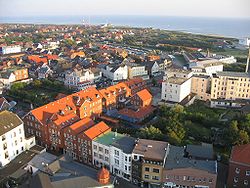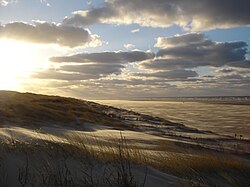Origins
During the last ice age, which ended approximately 12,000 years ago, sea level was about 60 metres (200 ft) lower than it is now, and part of what is now the North Sea was dry land. With the melting of the ice caps, the sea level rose, reaching the current coast line around the beginning of the Holocene era, approximately 7,000 years ago. Tidal action transported large quantities of sand to form a line of dunes extending over 500 kilometres (310 mi) from the Netherlands to the mouth of the river Elbe in Germany. The sea broke through the dunes in many places to form the Wadden Islands, with the low-lying country behind becoming the tidal Wadden mudflats.
The Dutch West Frisian and the German East Frisian Islands are barrier islands. [1] They arose along the breakers' edge where the water surge piled up sediment, and behind which sediment was carried away by the breaking waves. Over time, shoals arose, which ultimately were only covered by infrequent storm floods. [1] Once plants began to colonize the sandbanks, the land began to stabilize. [2]
In contrast, the North Frisian Islands arose from the remains of old Geestland islands, where the land was partially removed by storm floods and water action and then separated from the mainland. They are, therefore, often higher and their cores are less exposed to changes than the islands to the south. Beyond the core, however, the same processes are at work, as is particularly evident on Sylt, where the south of the island threatens to be broken away and the harbour at List in the north silts up. [3] The Danish Islands, the next in the chain to the north, arose from sandbanks. Into the 20th century, silt on the islands was a serious problem. To protect them, small woods were planted.
Habitation
Long before the beginning of the modern era, there were already humans inhabiting the Wadden area. Up to 800 AD, most inhabitants lived on terpen (artificial mounds). Living conditions were difficult. The Roman naturalist Pliny, writing in the first century AD, described the Frisians as ...
... people who live without trees or shrubs. ... in the east, to the coasts of the ocean, a number of races in such needy conditions exist; but this also applies to the races of peoples which are called the large and small Chaucen, which we have seen in the north. There, two times in each period of a day and a night, the ocean with a fast tide submerges an immense plain, thereby the hiding ... whether the area is sea or land. There this miserable race inhabits raised pieces ground or platforms, which they have moored by hand above the level of the highest known tide. Living in huts built on the chosen spots, they seem like sailors in ships if water covers the surrounding country, but like shipwrecked people when the tide has withdrawn itself, and around their huts they catch fish which try to escape with the expiring tide. It is for them not possible to keep herds and live on milk such as the surrounding tribes. They cannot even fight with wild animals, because all the bush country lies too far away. They braid ropes of sedges and rushes from the marshes with which they make nets to be able to catch fish, and they dig up mud with their hands and dry it more in wind than in the sun, and with soil as fuel they heat their food and their own bodies, frozen in northern wind. Their only drink comes from storing rain water in tanks front of their houses. And these are the races which, if they were now conquered by the Roman nation, say that they will fall into slavery! It is only too true: Destiny saves people as a punishment. [4]
Around 1000AD, dike construction began. Monks were instrumental in this activity, among others those of the monastery of Aduard. But earlier attempts had been undertaken to dam the sea. At the Frisian Peins (near Franeker), a 40-meter section of dike has been discovered that is thought to date from the 1st or 2nd century BC.
In the late Middle Ages, the dike system was gradually strengthened and flooding diminished. Beginning in the 17th century, dikes were built further out to reclaim more land. This activity peaked in the 19th and 20th centuries.
Conservation of the West Frisian/Dutch coast
The dunes south of the Wadden Sea were also liable to this process, but human intervention prevented the many storm surges from changing the coast of the provinces North Holland and South Holland into separate islands with Wadden mudflats behind them. However, around 1200AD, storm surges did break up the northern coast of Western Friesland into five islands. Around 1600AD, four of these along the West coast had been again recovered, but Wieringen, to the south-east of Texel, remained an island up to the 20th century.


















